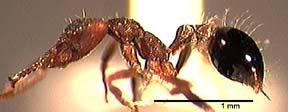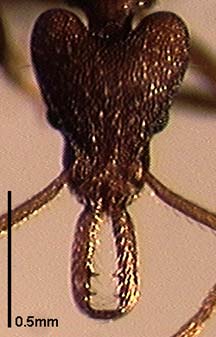Strumigenys biolleyi Forel 1908
Dacetini, Myrmicinae, Formicidae, Hymenoptera, Insecta, Arthropoda, Animalia
John T. Longino, The Evergreen State College, Olympia WA 98505
USA.
longinoj@evergreen.edu
14 April 1997
Identification

Specimen: Costa Rica, Prov. Heredia: La Selva Biological Station (C. Thompson 232-A). INBIOCRI001254095. Image by J. Longino.
Apical fork of mandible with a single intercalary tooth; mandible with two conspicuous preapical teeth; gastral dorsum smooth and shining; mandibles shorter than head; propodeal lamellae without dorsal teeth or angles (dorsal angle present in smithii), ventral angle present and prominent.
Head length 0.60-0.81mm, mandible length 0.35-0.51, CI 78-85, MI 58-66 (n=51 workers from 11 localities; Brown 1962).
Similar species: smithii, godmani
Range
Southern Mexico (Chiapas) to Ecuador; in Costa Rica common on the Atlantic slope and montane areas to 1600m; appears absent from lower Pacific slopes.
|

Specimen: Costa Rica, Prov. Heredia: La Selva Biological Station (C. Thompson 232-A). INBIOCRI001254095. Image by J. Longino. |
Natural History
Brown and Wilson (1959) summarize the genus as follows: "Widespread in tropics and warm temperate areas. Primarily forest-dwelling; some species occur in grassland and arid scrub. ... Nests mostly in soil and rotting wood; a few species live in arboreal plant cavities in tropical rain forest. Foraging hypogaeic to epigaeic-arboreal. Food: most species are collembolan feeders; a few are polyphagous predators or occasionally feed on sugary substances..."
biolleyi occurs in wet forest habitats. It nests on the forest floor, in dead wood, rotten twigs, and under loose bark. Workers forage nocturnally.
Selected Records
Winkler samples from La Selva, Tortuguero, Rara Avis, Hitoy Cerere, Penas Blancas Valley, Monteverde, Est. Biol. Pittier, San Vito.
Braulio Carrillo National Park at 500m: mature wet forest. Colony in small, 2cm long chamber in rotten log.
Braulio Carrillo National Park, Bajo la Hondura: under loose bark of rotten log.
Monteverde: nest with queen; entire nest collected; in cavity in rotten wood on ground. 134 workers, 1 queen in collection. Also 3 small live millipedes were in the nest. Possible inquilines?
Literature Cited
Brown, W. L., Jr. 1962. The neotropical species of the ant genus Strumigenys Fr. Smith: Synopsis and keys to the species. Psyche 69:238-267.
Brown, W. L., Jr., Wilson, E. O. 1959. The evolution of the dacetine ants. Quart. Rev. Biol. 34:278-294.
 Go back to top
Go back to top

